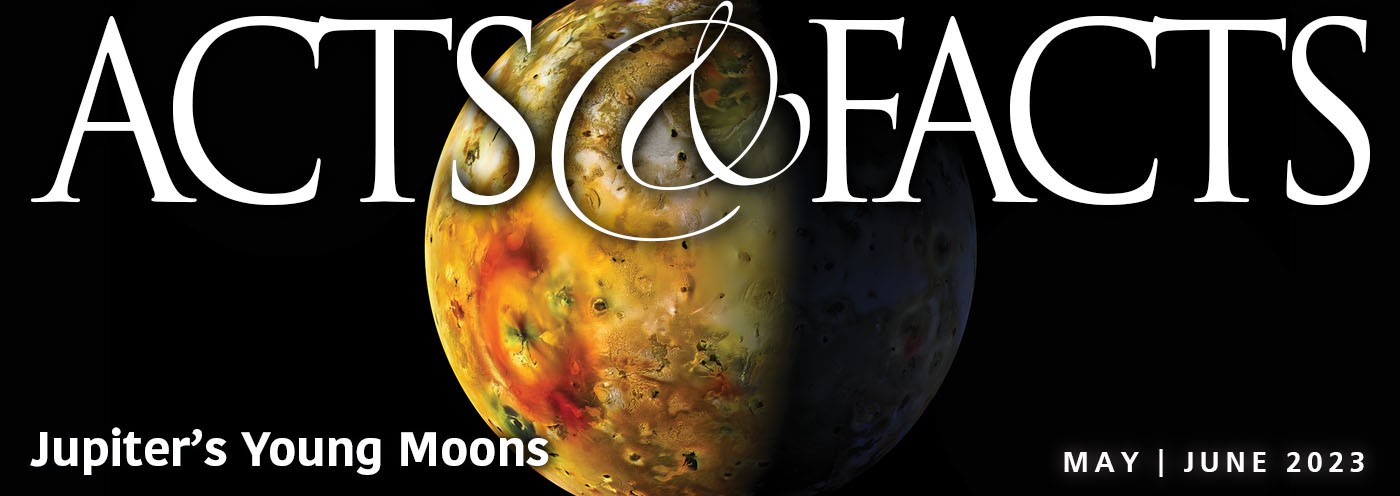Introduction
If the Flood really happened as described in Genesis, then the earth's atmosphere, ocean, and crust would have been severely disrupted. Following the Flood, it would have taken thousands of years for these systems to return to a new equilibrium and even then, these systems would continue to exhibit slow changes. It is widely recognized that small changes in the ocean will have large influences on the atmosphere. Not only does the ocean contain over 300 times more mass than the atmosphere, but it also contains over 1000 times more heat energy than the atmosphere. A change of only a few degrees in the sea-surface temperature will exchange large quantities of energy with the atmosphere. The exchange of water vapor, carbon dioxide, and other constituents between the ocean and the atmosphere are also important, particularly when the ocean temperature changes. Some of these constituents can have important climatic effects.
The writer1,2 has discussed some of the likely effects of a catastrophic, global Flood on cooling of the oceans and the formation of an "Ice Age." He3 has also discussed the greenhouse effect but has not, up until now, considered the direct contribution of the Flood to global warming. Following two large-scale field experiments in 1993 and 1995 to test the hypothesis that major portions of the ocean are deficient in iron, it is now reasonable to suggest that decreases in iron concentration in the oceans following the Flood may have contributed to global warming some time afterward. This warming helped melt the glaciers and ice sheets and bring about the end of the "Ice Age." Compared to the events of the Flood, variations in carbon dioxide observed today are not likely to produce the magnitude of temperature change estimated from the past or projected by some for the future.
The Catastrophic Nature of the Flood
The Biblical description in Genesis 7 and 8 clearly indicates that the flood was global and covered the highest mountains. Such a flood which destroyed all mankind and every terrestrial, air-breathing animal except those in the Ark, could only be considered to be catastrophic. The upper crust of the earth also gives evidence that the Flood was not tranquil but violent and destructive. On average, the continental crust of the earth is covered with about a mile of sediments which appear to have been formed by the Genesis Flood.
If the Flood was catastrophic, then it is likely that when the Flood ended, the oceans were well mixed from top to bottom and from equator to pole. This mixing would not only have distributed the heat released from friction and the magma in volcanoes and mid-ocean ridges throughout the entire volume, but would also have distributed nutrients and minerals derived from the sediments. It appears that a slurry of mud and sand was formed in the oceans by the action of the Flood events, which was deposited onto the continents and ocean floors to form the sedimentary rock layers. The ocean would have dissolved many nutrients and minerals from the sediments so that phytoplankton would grow rapidly in the warm, nutrient-rich conditions following the Flood. When phytoplankton is present, zooplankton can then grow rapidly to support the entire food chain. If phytoplankton bloomed worldwide for several hundred years after the Flood, it would probably have absorbed tremendous quantities of carbon dioxide, drawing down the concentration of carbon dioxide in the atmosphere. This, in turn, may have helped create a cooling of the atmosphere contributing to the "Ice Age."
Because the growth of phytoplankton occurs only in the upper few hundred feet of the ocean where sunlight can penetrate, upwelling would need to replenish the surface layers with nutrients and minerals. In the polar regions where rapid surface cooling occurred, convective upwelling probably supplied plentiful nutrients, even though the sunlight was less intense than in the tropical regions. Along continental boundaries and near the equator, strong upwelling occurs today producing a continuous growth of phytoplankton with organic sediments. Approximately 1500 feet of soft sediments are found on the ocean floor along the equator where the North and South Pacific Ocean converge to produce upwelling. In the mid-ocean gyres where downwelling occurs certain nutrients are deficient and little marine life exists.
Iron Deficiency in the Ocean Today
It has long been hypothesized that iron concentrations limit phytoplankton productivity in some parts of the ocean.4,5,6 As a result, iron may have played a role in modulating atmospheric carbon dioxide levels7 and consequently atmospheric temperature. It has been suggested that in high nutrient, low chlorophyll regions of the world's oceans biological activity does not completely remove nitrate and phosphate from surface waters. These regions are typically in the middle of the world's oceans, away from continents and upwelling regions. Production of phytoplankton which absorbs carbon dioxide is less in these waters than it would be if all the nutrients were consumed, while the carbon dioxide content of the waters is substantially higher. This leads to higher levels of carbon dioxide in the undisturbed atmosphere than would otherwise be the case. Martin6,7 hypothesized that the root cause of this was limitation by iron. He conducted case studies showing that when dust was blown into these regions of the ocean from continental deserts, the phytoplankton bloomed. He also collected water samples from the ocean in laboratory bottles and introduced low concentrations of iron. Phytoplankton grew rapidly upon the addition of iron and carbon dioxide was reduced.
The late John Martin was the director of the Moss Landing Oceanographic Laboratory when he facetiously tossed off the comment: "Give me half a tanker of iron and I'll give you an Ice Age!" in his best "Dr. Strangelove" accent during a lecture in 1988. Martin died before his theory could be confirmed in the field. But his Moss Landing colleagues conducted two field experiments funded by the National Science Foundation to test his controversial theory. The results were remarkable.
In the Fall of 1993 and again in 1995, a 250-square-mile patch of ocean was "seeded" with iron sulfate near the Galapagos Islands off the western coast of South America. Within hours of the release of the iron in a pristine, clear blue ocean with 200-foot visibility, phytoplankton began to grow, turning the ocean a murky green with 4- to 6-foot visibility. The patches were observed for almost a week as they drifted with the current and at first grew thicker in phytoplankton and then slowly dispersed and were eaten by grazing zooplankton.
The result of these experiments was a doubling of plant biomass, a threefold increase in chlorophyll, and a fourfold increase in plant production for a short period of time.8 The partial pressure of carbon dioxide at the ocean surface was significantly reduced within 48 hours of the iron release, but the effect was only about 10% of the potential reduction if all the available nitrate and phosphate had been utilized.9 So, it is evident that a deficiency in iron limits the growth of marine phytoplankton and probably, as a consequence, the entire marine food chain.
Atmospheric Carbon Dioxide Changes and Global Warming
If the above scenario were to be repeated on a global scale with iron distributed throughout the entire volume of ocean, it is likely that some of the effects of the Genesis Flood could be duplicated. A rapid bloom of phytoplankton probably turned the oceans a murky green worldwide following the Flood and dramatically reduced the carbon dioxide in the atmosphere which, in turn, caused atmospheric cooling. This cooling would have contributed to the "Ice Age" initially. But, when the nutrients and minerals, particularly iron, began to be depleted, the growth of phytoplankton would have decreased and less carbon dioxide would have been removed from the atmosphere. Carbon dioxide concentrations would have increased again and the atmosphere would have warmed, ending the "Ice Age." Glaciers and ice sheets covering a large portion of the continents would have melted. Evidence for reduced carbon dioxide concentrations during the "Ice Age" and an increase during the last few thousand years has been found.10
Today the atmosphere has reached a new equilibrium. This equilibrium followed a depletion of oceanic nutrients and minerals, a reduction in the growth of phytoplankton, an increase in carbon dioxide in the atmosphere, warming of the atmosphere, and the melting of glaciers and ice sheets. The increase we are now observing in carbon dioxide concentration at Mauna Loa is probably due to minor variations in ocean temperature and circulations plus some anthropogenic contributions. The amount of energy change in today's world is extremely small compared to that which occurred during the Flood. Global warming due to these changes will probably be minor. In addition, the atmosphere/ocean system is a very stable system. It is not only a very massive system which damps small changes, but also has many self-regulating systems which counteract destabilizing influences.
If one ignores the Flood and its massive influence and attempts to explain climate change by small astronomical variations,11,12 then it is understandable why so much concern is expressed about the recent variations in carbon dioxide on global temperatures. However, if one recognizes the impact of the Flood on geophysical and biological systems, not only during its most active period but also following, these current apocalyptic concerns pale into insignificance. I believe the current attempt to mitigate hypothesized global warming is not supported by the evidence and is premature at best. The real driving force behind the current controversy is politics, not science.
References
1 Vardiman, L. 1996. "Cooling of the Ocean After the Flood." Institute for Creation Research, Impact Article #277. San Diego, CA. 4 pp.
2 ______, 1994. "Out of Whose Womb Came the Ice?" Institute for Creation Research, Impact Article #254. San Diego, CA. 4 pp.
3 ______, 1990. "The Christian and the Greenhouse Effect." Institute for Creation Research, Impact Article #204. San Diego, CA. 4 pp.
4 Hart, T.J. 1934. "On the Phytoplankton of the South-West Atlantic and the Bellingshausen Sea 1929-31." Discovery Reports 8, pp. 1-268.
5 Moore, R.M., J.E. Milley, and A. Chatt 1984. "The Potential for Biological Mobilization of Trace Elements from Aeolian Dust in the Ocean and Its Importance in the Case of Iron." Oceanologica Acta 7, pp. 221-228.
6 Martin, J.H., S.E. Fitzwater, and R.M. Gordon 1990. "Iron Deficiency Limits Phytoplankton Growth in Antarctic Waters." Global Biogeochemical Cycles 4, pp. 5-12.
7 Martin, J.H., 1990. "Glacial-Interglacial CO2 Change: The Iron Hypothesis." Paleoceanography 5, pp. 1-13.
8 Martin, J.H., K.H. Coale, K.S. Johnson, S.E. Fitzwater, R.M. Gordon, S.J. Tanner, C.N. Hunter, V.A. Elrod, J.L. Nowickl, T.L. Coley, R.T. Barber, S. Lindley, A.J. Watson, K. Van Scoy, C.S. Law, M.I. Liddicoat, R. Ling, T. Stanton, J. Stockel, C. Collins, A. Anderson, R. Bidigare, M. Ondrusek, M. Latasa, F.J. Millero, K. Lee, W. Yao, J.Z. Zhanag, G. Friedrich, C. Sakamoto, F. Chavez, K. Buck, Z. Kolber, R. Greene, P. Galkowski, S.W. Chisholm, F. Hoge, R. Swift, Yungel, S. Turner, P. Nightingale, A. Hatton, P. Liss, and N.W. Tindale 1994. "Testing the Iron Hypothesis in Ecosystems of the Equatorial Pacific Ocean." Nature 371, pp. 123-129.
9 Watson, A.J., C.S. Law, K.A. Van Scoy, F.J Millero, W. Yao, G.E. Friederich, M.I. Liddicoat, R.H. Wanninkhof, R.T. Barber, and K.H. Coale 1994. "Minimal Effect of Iron Fertilization on Sea-Surface Carbon Dioxide Concentrations." Nature 371, pp. 143-145.
10 Barnola, J.M., D. Raynaud, Y.S. Korotkevich, and C. Lorius 1987. "Vostok Ice Core Provides 160,000-Year Record of Atmospheric CO2." Nature 329, pp. 408-414.
11 Hays, J.D., J. Imbrie, and N.J. Shackleton 1976. "Variations in the Earth's Orbit: Pacemaker of the Ice Ages." Science 194, pp. 1121-1132.
12 Vardiman, L. 1995. "A Faulty Climate Trigger." Institute for Creation Research, Impact Article #261, 4 pp.
*Dr. Vardiman is Chairman of the Astro/Geophysics Department at ICR.
















